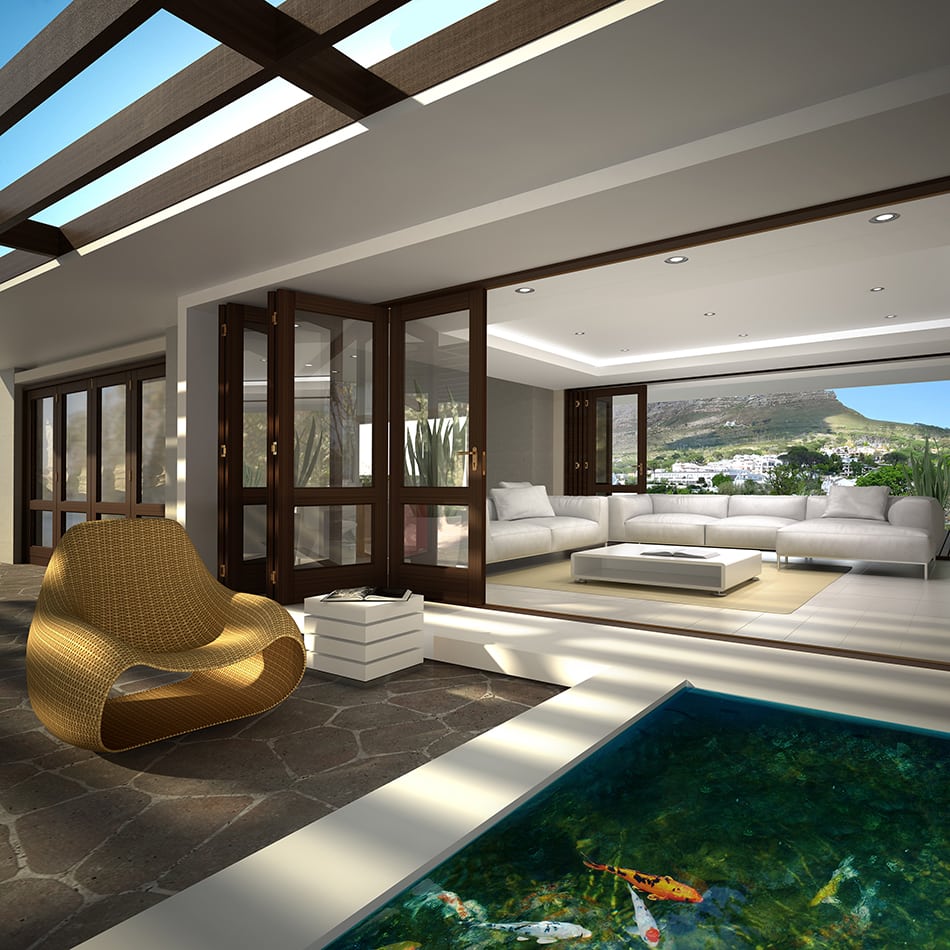Patio Doors: The Swartland Buyer’s Guide
Patio doors are a great way of connecting your home’s indoor and outdoor spaces. We speak to Cobus Lourens from leading window and door manufacturer, Swartland, about what needs to be considered when selecting patio doors for your home.
Patio doors offer a way of allowing more natural light into your home’s interior spaces, as well as creating a flow to the outdoors. Cobus Lourens shares the following guidelines to help you make the best possible choice when it comes to your patio doors!
Savvy on style
“Any patio door must meet your requirements – both from a functional and an aesthetic point of view. They need to complement the architectural style of your home, be easy to operate, and protect you from the elements,” notes Cobus. He says that the majority of patio doors can be broken down into the following categories:
- Sliding patio doors: These doors comprise two or more individual panels, one of which slides back and forth over a fixed panel. The sliding panels are combined with fixed panels to create dramatically broad expanses of glazing. A major benefit of sliding doors is that they slide open parallel to one another and do not require any space for an opening arc, so they don’t interfere with furniture placement or foot traffic. This makes them a great choice for more compact spaces. Says Cobus: “It is important to ensure that the sliding doors you choose boast superior rail hardware that allows the doors to glide open and close effortlessly.”
- Hinged patio doors: These doors operate the same way as traditional doors, and are usually installed in pairs. They are available in a wide variety of styles, including designs with single or multiple lites or panes. They are hinged on opposite sides, and can be installed to open outwards or inwards, depending on what best suits the installation application. The latching mechanism is mounted on one of the doors, and when open, the entire area between the two opposite hinged sides is clear.
- Fold-a-side patio doors: These doors are able to span the largest opening of all door styles – allowing for openings of between 2 and 5 metres in length. They operate accordion-style, and neatly fold away for full access. They are available in various configurations – from three to six leaves. Cobus says that Swartland offers fold-a-side doors in timber, and now, they have recently launched fold-a-side doors in its very popular KENZO aluminium range as well.
Making the most of materials:
Although aesthetics are important, the construction and materials used to make the patio doors of your choice is also a very important consideration. Cobus notes that although there are a few materials that are used to make patio doors, the most popular two materials are undoubtedly timber and aluminium: “Wood and aluminium are by far the most popular options when it comes to patio doors as both materials offer great benefits.”
- Aluminium: Patio doors made from aluminium, such as Swartland’s KENZO range for example, are becoming increasingly sought after, Aluminium is an affordable, lightweight and durable material that is corrosion-resistant and performs well in the majority of climates. It is powder-coated, so it doesn’t need to be painted, and it boasts narrow profiles for a sleek and subtle visual appeal. Says Cobus: “Its natural strength means that aluminium doors can have really slim frames and hold more glass – meaning bigger doors with more glazing. This quality allows the outdoor views to take centre stage instead of the doors themselves.”
- Timber: If it is sourced from sustainably managed forests, wood boasts unsurpassed green credentials as a building material – it offers excellent insulation, it is durable and long lasting, and like aluminium, it is very easy to recycle. Wood also offers rich and warm good looks, and if sealed with a water-based sealant, it no longer requires a lot of maintenance to keep it looking its best. Says Cobus: “As part of our environmental responsibility, Swartland has always strived to make quality products that are durable and long lasting. Which is why we kiln-dry our wood to a moisture content of 8%. This process helps keep the wood in perfect balance with local atmospheric conditions, thereby stabilising the timber and minimising movement or warping.”
Great glazing options
Electricity is becoming increasingly expensive, so when building or renovating, it is always a wise idea to do everything in your power to minimise the costs of heating and cooling your home. Selecting the right patio doors is a critical step, says Cobus: “Choosing energy efficient glazing for your patio doors will not only save you a lot of money over their lifespan, but it is also the responsible thing to do regarding the environment.”
The technical term for the glass that is installed into windows or doors is glazing. You can select various glazing coatings that can play a massive part in the insulative qualities of your windows and doors, says Cobus: “Low-E glazing, or low emissivity glass, for example, is coated with a thin metallic substance that increases the window’s ability to reflect, rather than absorb heat. Although Low-E glazing costs more than normal glazing, it can save you lots of money in the long run, as it ensures excellent insulation.” He notes that apart from insulation, glazing can also come with coatings that offer other desirable qualities, such as protection, safety, security, solar and sound control, UV-protection, and decoration. He notes that at the very least however, your doors must be fitted with safety glass: “It is the law to fit all doors with 5mm safety glass.”
For more visit Swartland.
You might also like...
-
Maximizing Natural Light: Design Strategies for Brighter Interiors

Natural light is one of the most powerful tools in interior design. It has the ability to change the mood of a room, influence energy ...
-
Window Screen Replacement Made Easy: Compare Your Options

If your window screen is sagging or torn, it’s time for a replacement. A damaged screen mesh can let in unwanted bugs and reduce ...
-
Choosing the Perfect Curtains for Your Home

Choosing the perfect curtains for one’s home can be a complex yet rewarding task. The right curtains not only enhance the overall aesthetics of a ...

























